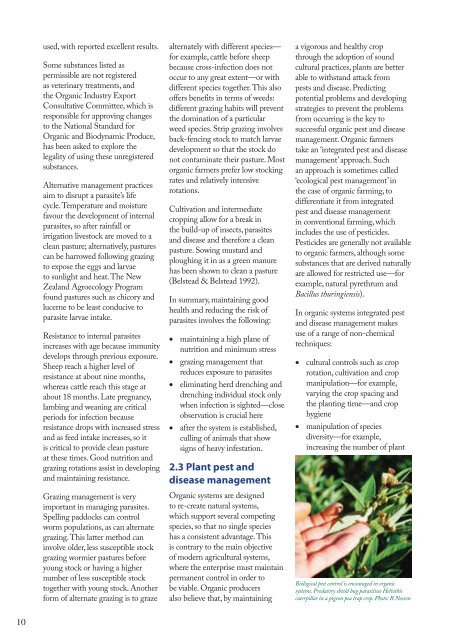4. Organic vegetable production
4. Organic vegetable production
4. Organic vegetable production
You also want an ePaper? Increase the reach of your titles
YUMPU automatically turns print PDFs into web optimized ePapers that Google loves.
used, with reported excellent results.<br />
Some substances listed as<br />
permissible are not registered<br />
as veterinary treatments, and<br />
the <strong>Organic</strong> Industry Export<br />
Consultative Committee, which is<br />
responsible for approving changes<br />
to the National Standard for<br />
<strong>Organic</strong> and Biodynamic Produce,<br />
has been asked to explore the<br />
legality of using these unregistered<br />
substances.<br />
Alternative management practices<br />
aim to disrupt a parasite’s life<br />
cycle. Temperature and moisture<br />
favour the development of internal<br />
parasites, so after rainfall or<br />
irrigation livestock are moved to a<br />
clean pasture; alternatively, pastures<br />
can be harrowed following grazing<br />
to expose the eggs and larvae<br />
to sunlight and heat. The New<br />
Zealand Agroecology Program<br />
found pastures such as chicory and<br />
lucerne to be least conducive to<br />
parasite larvae intake.<br />
Resistance to internal parasites<br />
increases with age because immunity<br />
develops through previous exposure.<br />
Sheep reach a higher level of<br />
resistance at about nine months,<br />
whereas cattle reach this stage at<br />
about 18 months. Late pregnancy,<br />
lambing and weaning are critical<br />
periods for infection because<br />
resistance drops with increased stress<br />
and as feed intake increases, so it<br />
is critical to provide clean pasture<br />
at these times. Good nutrition and<br />
grazing rotations assist in developing<br />
and maintaining resistance.<br />
Grazing management is very<br />
important in managing parasites.<br />
Spelling paddocks can control<br />
worm populations, as can alternate<br />
grazing. This latter method can<br />
involve older, less susceptible stock<br />
grazing wormier pastures before<br />
young stock or having a higher<br />
number of less susceptible stock<br />
together with young stock. Another<br />
form of alternate grazing is to graze<br />
alternately with different species—<br />
for example, cattle before sheep<br />
because cross-infection does not<br />
occur to any great extent—or with<br />
different species together. This also<br />
offers benefits in terms of weeds:<br />
different grazing habits will prevent<br />
the domination of a particular<br />
weed species. Strip grazing involves<br />
back-fencing stock to match larvae<br />
development so that the stock do<br />
not contaminate their pasture. Most<br />
organic farmers prefer low stocking<br />
rates and relatively intensive<br />
rotations.<br />
Cultivation and intermediate<br />
cropping allow for a break in<br />
the build-up of insects, parasites<br />
and disease and therefore a clean<br />
pasture. Sowing mustard and<br />
ploughing it in as a green manure<br />
has been shown to clean a pasture<br />
(Belstead & Belstead 1992).<br />
In summary, maintaining good<br />
health and reducing the risk of<br />
parasites involves the following:<br />
• maintaining a high plane of<br />
nutrition and minimum stress<br />
• grazing management that<br />
reduces exposure to parasites<br />
• eliminating herd drenching and<br />
drenching individual stock only<br />
when infection is sighted—close<br />
observation is crucial here<br />
• after the system is established,<br />
culling of animals that show<br />
signs of heavy infestation.<br />
2.3 Plant pest and<br />
disease management<br />
<strong>Organic</strong> systems are designed<br />
to re-create natural systems,<br />
which support several competing<br />
species, so that no single species<br />
has a consistent advantage. This<br />
is contrary to the main objective<br />
of modern agricultural systems,<br />
where the enterprise must maintain<br />
permanent control in order to<br />
be viable. <strong>Organic</strong> producers<br />
also believe that, by maintaining<br />
a vigorous and healthy crop<br />
through the adoption of sound<br />
cultural practices, plants are better<br />
able to withstand attack from<br />
pests and disease. Predicting<br />
potential problems and developing<br />
strategies to prevent the problems<br />
from occurring is the key to<br />
successful organic pest and disease<br />
management. <strong>Organic</strong> farmers<br />
take an ‘integrated pest and disease<br />
management’ approach. Such<br />
an approach is sometimes called<br />
‘ecological pest management’ in<br />
the case of organic farming, to<br />
differentiate it from integrated<br />
pest and disease management<br />
in conventional farming, which<br />
includes the use of pesticides.<br />
Pesticides are generally not available<br />
to organic farmers, although some<br />
substances that are derived naturally<br />
are allowed for restricted use—for<br />
example, natural pyrethrum and<br />
Bacillus thuringiensis).<br />
In organic systems integrated pest<br />
and disease management makes<br />
use of a range of non-chemical<br />
techniques:<br />
• cultural controls such as crop<br />
rotation, cultivation and crop<br />
manipulation—for example,<br />
varying the crop spacing and<br />
the planting time—and crop<br />
hygiene<br />
• manipulation of species<br />
diversity—for example,<br />
increasing the number of plant<br />
Biological pest control is encouraged in organic<br />
systems. Predatory shield bug parasitises Heliothis<br />
caterpillar in a pigeon pea trap crop. Photo: R Neeson<br />
10

















